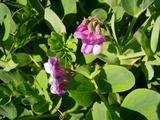630903 Lathyrus japonicus Willd.
Distribution
Northern Iceland: Scattered
Northern Fennoscandia: Scattered
Kanin - Pechora: Scattered
Kharaulakh: Rare
West Chukotka: Scattered
South Chukotka: Scattered
East Chukotka: Scattered
Western Alaska: Frequent
Northern Alaska - Yukon: Rare
Central Canada: Rare
Hudson Bay - Labrador: Scattered
Western Greenland: Rare
Eastern Greenland: Rare
Southern Arcti Tundra: Rare
Shrub Tundra: Frequent
Bordering boreal or alpine areas: Frequent
2n=
(1) 14 (2x). - Europe (N), Far East (N, S), Alaska, Canada, U.S.A. (NE), Greenland. - Numerous reports for "aleuticus", "japonicus", "maritimus", and "pubescens".
(2) 28 (4x). - Far East (Japan). - Tatuno and Kodama (1965).
(3) 56 (8x). - Far East (Japan). - Tatuno and Kodama (1965).
Geography: Amphi-Pacific/Beringian - North American - amphi-Atlantic - European: ICE NOR RUS SIB RFE ALA CAN GRL.
Notes: Both the names and the subdivision of the widespread and not very polymorphic seashore species Lathyrus japonicus have been discussed.
Species name. - The species was first described by Linnaeus in 1753 from western Europe as Pisum maritimum, then by Willdenow in 1803 from Japan as Lathyrus japonicus, and then again by Bigelow in 1824 from eastern North America as Lathyrus maritimus. Bigelow did not base his name on Linnaeus' Pisum maritimum because he (erroneously) assumed his plant to be different from that of Linnaeus. In 1835, Fries recombined Linnaeus' Pisum maritimum as Lathyrus maritimus (L.) Fr. but this combination is invalidated by Bigelow's independent name and predated by Willdenow's name. Mansfeld (1939) argued for the validity of L. maritimus and Ball (1968) for the priority of L. japonicus. Most authors have subsequently accepted Ball's arguments and applied the name L. japonicus for the species but the epithet "maritimus" is available for a European or Atlantic subspecies if such a one is recognized.
Variation. - The species varies in, e.g., leaflet size, shape, and structure, number of flowers in the inflorescence, size of flowers, and in pubescence (or not) on different plant parts. The pubescence has been given much attention. Hultén (1971a) and Hultén and Fries (1986) mapped an intricate circumpolar pattern of glabrous and pubescent plants. That character is not reliable alone. However, almost all Japanese ("japonicus") and temperate northwestern European plants ("maritimus") are glabrous, whereas subarctic to arctic North Atlantic, North Pacific, and Beringian plants mostly are more or less pubescent.
Name of subspecific taxa. - As possible names for subspecies, "maritimus" has mostly been assigned to the glabrous plants and "japonicus" to the pubescent ones. This is perhaps not appropriate in view of the Hultén maps with glabrous Japanese plants. There are also divergent opinions about whether the Linnaean "maritimus" name belongs to glabrous or pubescent plants. Seringe in De Candolle, Prodr. 2: 368 (1825), described a Pisum maritimum var. glabrum, which means that Pisum maritimum (s. str.) should be based on a pubescent lectotype if such ones are available in the original material. Hartman, Handb. Scand. Fl., ed. 2: 198 (1832), did the opposite and described a Pisum maritimum var. pubescens, implying that the type P. maritimum is glabrous. This approach has been the one mainly followed by subsequent authors, including Regel who in 1935 recombined Hartman's variety as a subspecies within L. maritimus Bigelow. However, Seringe's choice has priority if the original material cited by Linnaeus includes both glabrous and pubescent plants. Linnaeus' description does not mention any relevant characters and Jonsell and Jarvis (2002) did not mention whether their chosen lectotype was glabrous or pubescent.
Korobkov (1986) published a new subsp. pubescens within L. japonicus, with a type from the Murman Coast, but 'synonymized' it both with Pisum maritimum var. pubescens Hartm., which he considered a nomen ambiguum, and with Lathyrus maritimus taxon aleuticus Greene, described in 1894 from the Aleutian Islands (where most plants are pubescent). According to Yurtsev (in comment), Korobkov did not include pubescent western European plants in his L. japonicus subsp. pubescens but rather regarded these within a more southern subsp. maritimus sensu Ball. Korobkov's 'synonymization' with Hartman's pubescent variety may be due to a Russian practice in citing as synonyms applications rather than names as based on types. Korobkov's heterotypic subsp. pubescens is an illegitimate homonym according to the current Code (see McNeill et al. 2006: article 53.4), predated by Hartman's var. pubescens.
Yurtsev reported the following characters: "In the latter subsp. [pubescens Korobkov], however, floriferous stems in their upper parts, leaflets (on lower surface), peduncles, pedicels, and calyces always shortly and densely pubescent. From subsp. pubescens Korobkov, subsp. maritimus differs in somewhat incrassate (in vivo) leaflets, becoming coriaceous in sicco, strongly nervate, a greater number of flowers in a raceme, their smaller size, which determines the greater resemblance of the northern race to subsp. japonicus, from which it, in its turn, can be separated by a number of characters, listed in the Latin diagnosis of Korobkov. Among them are, besides the stable short dense pubescence of the abovementioned parts of the plant, a humilior habit, shorter or even reduced cirri, somewhat smaller flowers."
The question of names then boils down to whether one assumes the pubescent northwestern European plants ("maritimus" sensu Seringe, "pubescens" sensu Hartman) to be racially different from the pubescent northern-northeastern European plants ("pubescens" sensu Korobkov) and the pubescent Beringian plants ("aleuticus"). In view of this complication, no racial division is accepted for the Checklist. We just state that glabrous plants are reported in the Arctic as scarce from northern Norway, both sides of the Bering Strait, the Mackenzie River Delta, and the southern Hudson Bay, whereas pubescent plants are reported from nearly everywhere the species occurs.
Higher Taxa
- Lathyrus [6309,genus]
